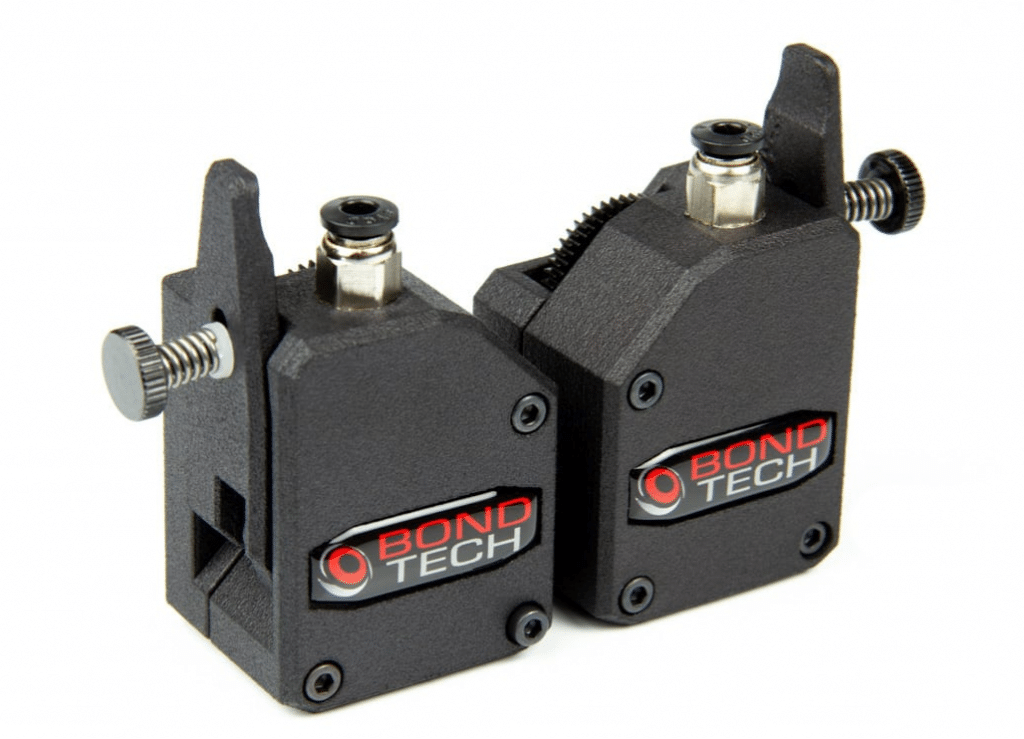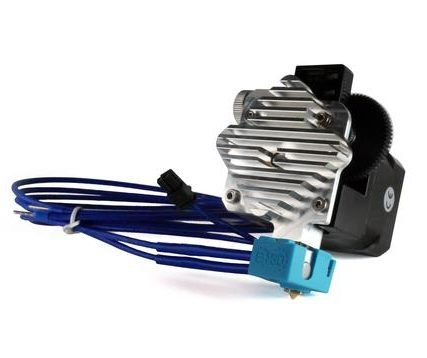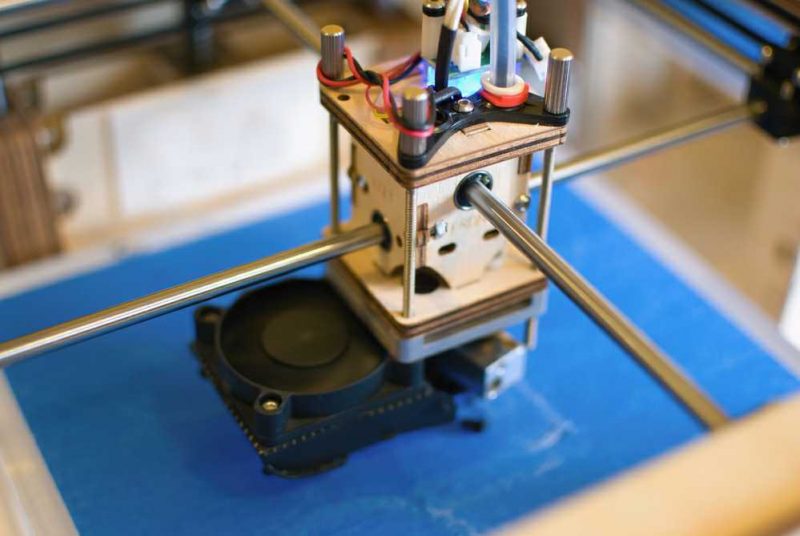An extruder is an essential part of your 3D printer. This comprehensive guide will cover everything you need to know about extruders. We will review everything from how they work and how to choose one to the best options in 2021!
What is a 3D Printer Extruder?
This vital component is what allows your 3D printer to lay the material in the layers needed to create your object. It can sometimes be called a feeder drive, and it is used to push the filament out into the appropriate place.
The extruder has a motor, a bearing that tightens the filament against the wheel, a sprocket, and a hot end. We will cover hot ends in greater detail later on, just know that this piece is where the printing material is melted.
Sometimes the extruder works to place a bonding agent that helps solidify a material that started in powder form. The function really depends on the specific product you are working on. In other words, this tiny piece is what makes the entire 3D printing process happen!
Most 3D printers use a process called Fused Deposition Modeling, or FDM. This involves feeding a thread of plastic material through a heated block and nozzle. The filament melts as it passes through the extruder, and it is then laid out in a preset pattern. The pattern keeps repeating itself in the stacking until you are left with the 3D object you wanted to create!
The term extruder refers to the portion of the 3D printer that feeds the plastic material and melts it onto the designated location. Without the extruder, you would not be able to perform fused deposition modeling.
If you choose an advanced 3D printer, it might have dual extruders. That is a fancy term for an extruder that has two separate printheads or a dual extruder 3d printer. They work together to print multiple models and can even function independently to create two unique objects.
When it comes to finding an extruder for your 3D printer, you have two options: a direct drive or a Bowden extruder.

Direct Extruder

Direct drive extruders are unique because they sit right on top of the hot end. This means that the distance the material needs to travel is much lower, so you can use flexible filaments accurately and reliably.
Opting for a printer with a direct extruder gives you greater control of retraction too. It makes sense since there is less distance between the pinch action and the filament that passes through it. Similarly, this shorter distance means you’re less likely to bend or break the filament when it retracts.
Another thing to note about direct-drive extruders is that they can be taller and bulkier compared to other options. The motor sits on top of the hot end, so the space that the print head takes up is much larger.
If you don’t assemble the direct drive extruder properly, it will reduce your print quality and cause lurch or overshooting when changing directions.
Bowden Extruder

The other option you have for this component is the Bowden extruder. With this model, the cold end does not sit directly on top of the hot end. Instead, they are separated by a tube that you pass the filament through.
Since the motor is attached to the body of the 3D printer, you can use a much smaller print head. You might be wondering, what’s the benefit of this? One word: speed.
The mechanics of the Bowden extruder are not any different since the internal components are all the same. However, the print head can move without the extra weight of the motor. That means it can work much faster while also increasing accuracy and precision.
The Bowden extruders are not perfect, though, and the added distance that the filament needs to travel through has some drawbacks.
For example, since the piece that controls the pinch point is farther from the hot end, you increase your risk of lag in the system. Additionally, the filament can bend while it travels through the tube, and failing to correct this issue could lead to messy stringing.
How a 3D Printer Extruder Work

While it might seem complicated, the process is quite simple – and each component plays an important role.
The motor, for example, is what drives the filament material towards the correct position. The gears grab onto the plastic and use some force to push it down into the hot end.
Another way to visualize the process is to think of a glue gun. When you use a glue gun, you push a cold glue stick through the machine that heats it. As it melts, you can accurately place it where you need it to complete the project.
The difference here is that this process uses a motor to push the material through instead of your hand. The concept is similar, though – the extruder has to keep the filament steady, so you can melt it at the right time. It also needs to put the material in the right spot.
Cold End vs. Hot End
The cold end begins where you feed the filament through. You may have already guessed this by its name, but this part of the extruder is cold! Nothing is hot at this point, but the motor and gears begin to move the filament through the 3D printer.
Where you can find the cold end will vary depending on the type of part you have – remember that it’s different for direct drives and Bowden extruders. Regardless of the placement, the cold end is responsible for helping the material get to the hot end. It accomplishes this by pushing and pulling the piece in the direction that is requested by the 3D printer.
Okay, so what does a hot end do besides heat up?
Heating the filament is only part of the role that a hot end plays in the 3D printing process. The material has to be heated at the right temperature then rapidly cooled down, so it needs to manage that boundary effectively. In other words, the hot end is where the filament goes from solid to liquid so you can create your design.
A fan and heat sink continuously cool off the top part of the hot end. You need this in place to keep the filament from heating up too early. It’s called heat creep when this happens, and allowing the material to heat up too soon can mess up the entire printing process.
At the bottom of the hot end, you will find a heater block and cartridge, a nozzle, and a temperature relaying thermistor. The heater block is typically made of aluminum and allows the filament to seamlessly move into the nozzle and onto the object you are trying to print. The heater cartridge relies on an electric current to do exactly what you think it does – heat the rest of the hot end!
Choosing the Right 3D Printer Extruder
Now that you understand how an extruder works and the components it includes, it is time to take the next step: learning how to choose the right extruder.
As we mentioned earlier, you can choose between a direct or a Bowden extruder. There’s no right or wrong answer here, but the key is to consider the type of projects you will be working on.
Consider going with a direct extruder if you plan to use flexible filament for most of your projects. Since these components provide an immediate path to the nozzle, the conditions are optimized for flexible filaments. We’re not saying that you can’t use a Bowden extruder with flexible filament – it just means that it doesn’t provide the ideal environment.
When speed is the top priority, you should select a Bowden extruder. The lightweight printheads offer much faster speeds and can allow you to finish models quicker.
Choosing the right extruder involves more than deciding between a Bowden and a direct model. You also have to shop for the hot end, and this piece requires careful consideration.
As we mentioned, the type of materials you will be printing with is the first place to start. Some hot ends can reach higher temperatures than others, so you want to make sure that the one you choose can heat the type of filament you plan to use.
Carefully examine the materials that the hot end is made of. If you want the piece to last many years and still be functional, you probably don’t want to choose the cheapest hot end on the market. Quality materials will last longer and ensure that you end up with better models.
The size of the wheel in the extruder can also play an important factor. A larger wheel radius allows you to grip the filament better, but that will require you to have bigger components. Consider the space you have available for the 3D printer and how that will affect your choice of extruders!

Benjamin S

Mechanical Engineer
"I wish this existed years ago!"
Jiga is the best way to get the parts you need, when you need them.
Best 3D Printer Extruders and Hot Ends in 2021
We’ve covered all the basics for 3D printer extruders, so let’s get into the best options on the market in 2021.

BondTech BMG Extruder
Starting off our list for the top 3D printer extruders is BondTech. They have performed so well in the industry that their name has almost become synonymous with extruders.
Their gearing system uses two gears that counter-rotate, so the filament is held from both sides. They were the first company to add two wheels to the extruder, and it has made a world of a difference for flexible filament.
BondTech Extruders grip the filament well, so there is very little risk that it will lose its hold at the pinch point. It also allows you to consistently extrude without jamming problems that can just slow down the printing process.
The BondTech BMG models start at around $100, so they are right in the middle of the extruder price range.

E3D Titan Aero Hot End + Extruder
Next, we have the E3D Titan Aero, which is another fan favorite. Their engineers spent time creating a powerful but lightweight extruder that produces excellent results. It’s a compact direct drive hot end and extruder package.
These components are very reliable and come as part of their modular ecosystem. With that said, you can use them with a wide variety of 3D printers. That makes it a great solution regardless of the machine that you have! It’s also excellent with flexible materials due to its slim and compact body. This extruder combo is priced at just around $100.

Diabase Flexion Single Extruder
If your goal is to print flexible materials well, then look no further than the Diabase Flexion Single Extruder. This brand specifically designed its extruders to handle flexibles with ease, and their extruders can push out flexible materials almost twice as fast as other options.
The Diabase Flexion Single Extruder restricts the filament path so that the material has no room to squeeze out. This design simply forces the filament to take the path of least resistance!
It also uses very small teeth to grip the filaments – and the wire brush makes sure that they are cleaned regularly to maintain their effectiveness. You can purchase a Diabase Flexion Single Extruder for around $150.

DisTech Automation Prometheus V2 Hot End
This hot end is a perfect option if you need something durable and reliable. The Prometheus V2 Hot End stands out because the heat sink has a unique, flat profile. The nozzle is also made with stainless steel, so you can expect increased resistance to wear and tear.
Likewise, the fact that they use stainless steel nozzles allows you to make items that are food-safe. If you plan on printing goods that fall into this category, you must choose an extruder that can meet the requirements. This hot end fits on almost all FDM printers, and you can purchase it for around $80 online.

Zesty Nimble Remote Direct Extruder
Do you not want to choose between a Bowden and a direct extruder? Well, you can do this by purchasing the Nimble from Zesty. It’s priced reasonably at around $125, and it offers the advantages of both types of extruders.
The Zesty Nimble can give you the best of both worlds because it feeds the filament directly through the hot end, but the drivetrain is mounted like a Bowden extruder. As a result, the excess weight is removed from the print head so you can get the speed you want – without the drawbacks of feeding the filament through a tube.
When you want to have high-performance printing at top speeds, this is an ideal solution. Did we mention it’s only about 25 grams?

Slice Engineering Mosquito Hot End
The Slice Engineering Mosquito is a hot end that was designed for functionality. The hot end eliminates heat creep by including the frame on the cold end. The filament is fed down through the heater block, and the air gap uses a copper heatsink to support airflow. As a result, the heat stays right where it should – and maximizes the efficiency of your 3D printing project!
Mosquito hot ends can print at temperatures up to 450 degrees Celsius and prints up to 30% faster than other options. Overall, it’s a great solution for professional printing, and the cost starts at $149.99.
Flex3Drive G5
So, why should you consider the Flex3Drive G5? Besides the fact that it is an open-source solution – meaning, that you can print its parts with FDM, FFF, or SLA. It’s also very simple to change out your filaments. All you need to do is press a switch, and the tensioner will take care of the rest! You also do not have to worry about the printing materials coming loose, as the chromium spring steel windings hold on to the filament securely.
These steel windings wrap around a central core, so there is an absolute load transfer between the motor and extruder. The level of mechanical force applied is all that is needed, so you can do away with cumbersome springs and clips.
This option is ideal for creating crisp sharp prints, regardless of the filament you work with. The involute tooth profile enhances smoothness and consistency too, so you will always be satisfied with the quality of your prototypes.
You can choose between buying the hardware kit or the full SLS, so the cost will range from £55.00 to £71.71.

E3D Hemera
The E3D Hemera dual-drive extrusion system is also a great choice. This model has a fully hardened, stainless steel drive train. The optimized heatsink is another plus – since it improves filament control and lets you maximize your flexibility.
When it comes to extrusion systems, this one is unique because you can buy it in both Bowden and direct variants. As you can see, flexibility is emphasized in everything that they do – and these capabilities do not sacrifice performance!
It has a new heatsink design too, which improves on previous models. The airflow is diverted up and away from the heated bed and hot end, so you can decrease your risk of creating uneven stresses or warping.
The best way to see how well this extruder works is to try it for yourself. You can purchase the E3D Hemera Bowden Kit for £70.00.

Micro Swiss Direct Drive Extruder
Next up, we have the Micro Swiss Direct Drive extruder. The price of this extruder with the hot end starts at $99.75, so it is an ideal option that won’t break the bank.
This piece was designed as a drop-in system for CR10 or Ender printers. You don’t have to make any modifications to make them work – simply plug it in and get started! There are also no printed brackets, so the setup is as simple as possible.
The extruder has a dual-drive train, adjustable filament grip for easy loading, and impressive extrusion control. Its constrained filament path boosts accuracy and speed – so you won’t be disappointed with this choice!

DyzeXtruder Pro
When you need an extruder that offers high flow, high speed, and high heat capabilities, consider choosing the DyzeXtruder Pro. It’s a bit more expensive and retails for $200, but the performance speaks for itself!
This powerful option is built to work with any type of filament and is also very lightweight. That means that if you need a tool that is space-efficient but still gets the job done, this is a great option.
The extruder can exert up to 22 pounds of force. That means it can accomplish any of the 3D printing applications. It even has cooling fins on the back block to increase heat spreading!
Compared to its predecessors, the upgraded pro 1.75mm extruder has improved bearings and teeth to maximize performance.

Shaked S

